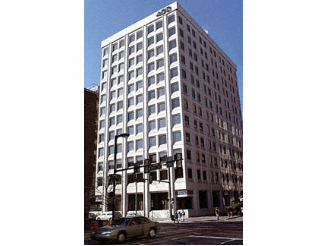Earlier this month, President Obama unveiled the Better Building Initiative (BBI), a public-private partnership that will invest $4 billion toward making federal and commercial office buildings more energy-efficient.
400 Market Street, an 11-story Philadelphia office tower built in 1972, is already serving as a model for how owners of hundreds of older, mid- and high-rise buildings throughout the Northeast and Midwest can reap the benefits of the program.
The 200,000 sf building, home to Philadelphia’s high-powered KWY-AM radio station, was recently renovated with a new HVAC system and a state-of-the-art window retrofitting system called RENOVATE by Berkowitz. According to energy modeling studies conducted with the U.S. Department of Energy’s most sophisticated energy modeling software, a typical 10- to 15-story office building like 400 Market Street could realize significant energy savings.
Developed by J.E. Berkowitz, a glass fabricator based in Pedricktown, N.J., the system works by converting existing single-pane windows into energy-saving, triple-glazed insulating glass units (IGUs) at a cost that is up to 50 percent less than ripping out and replacing old windows with new ones.
The window renovation system also has the benefit of being much faster and less disruptive to install. Berkowitz said the retrofit project for 400 Market Street took about 50 working days, which is two to three times faster than it would have been for a traditional “rip-out-and-replace” project for a similarly sized building. In addition, because the retrofitting was completed indoors, tenants were able to remain in their offices throughout the project. That is not possible with traditional window retrofitting solutions.
The BBI, which was first announced in January 2011, was developed to increase the energy efficiency in commercial buildings by 20 percent by 2020. Under the BBI, 60 private companies, municipal leaders and labor organizers have agreed on a plan to invest $2 billion of private capital to improve commercial, industrial, and manufacturing property. President Obama authorized the government to move forward with another $2 billion in energy-efficiency upgrades to federal buildings, which will be paid for by the long-term savings that the upgrades will provide. BD+C
Related Stories
University Buildings | Jun 28, 2024
The American University in Cairo launches a 270,000-sf expansion of its campus in New Cairo, Egypt
In New Cairo, Egypt, The American University in Cairo (AUC) has broken ground on a roughly 270,000-sf expansion of its campus. The project encompasses two new buildings intended to enhance the physical campus and support AUC’s mission to provide top-tier education and research.
MFPRO+ New Projects | Jun 27, 2024
Chicago’s long-vacant Spire site will be home to a two-tower residential development
In downtown Chicago, the site of the planned Chicago Spire, at the confluence of Lake Michigan and the Chicago River, has sat vacant since construction ceased in the wake of the Great Recession. In the next few years, the site will be home to a new two-tower residential development, 400 Lake Shore.
Codes and Standards | Jun 27, 2024
Berkeley, Calif., voters will decide whether to tax large buildings with gas hookups
After a court struck down a first-in-the-nation ban on gas hookups in new buildings last year, voters in Berkeley, Calif., will have their say in November on a measure to tax large buildings that use natural gas.
Mass Timber | Jun 26, 2024
Oregon State University builds a first-of-its-kind mass timber research lab
In Corvallis, Oreg., the Jen-Hsun Huang and Lori Mills Huang Collaborative Innovation Complex at Oregon State University aims to achieve a distinction among the world’s experimental research labs: It will be the first all-mass-timber lab meeting rigorous vibration criteria (2000 micro-inches per second, or MIPS).
Sustainability | Jun 26, 2024
5 ways ESG can influence design and create opportunities
Gensler sustainability leaders Stacey Olson, Anthony Brower, and Audrey Handelman share five ways they're rethinking designing for ESG, using a science-based approach that can impact the ESG value chain.
Student Housing | Jun 25, 2024
P3 student housing project with 176 units slated for Purdue University Fort Wayne
A public/private partnership will fund a four-story, 213,000 sf apartment complex on Purdue University Fort Wayne’s (PFW’s) North Campus in Fort Wayne, Indiana. The P3 entity was formed exclusively for this property.
Sustainability | Jun 24, 2024
CBRE to use Climate X platform to help clients calculate climate-related risks
CBRE will use risk analysis platform Climate X to provide climate risk data to commercial renters and property owners. The agreement will help clients calculate climate-related risks and return on investments for retrofits or acquisitions that can boost resiliency.
MFPRO+ News | Jun 24, 2024
‘Yes in God’s Backyard’ movement could create more affordable housing
The so-called “Yes in God’s Backyard” (YIGBY) movement, where houses of worship convert their properties to housing, could help alleviate the serious housing crisis affecting many communities around the country.
Student Housing | Jun 20, 2024
How student housing developments are evolving to meet new expectations
The days of uninspired dorm rooms with little more than a bed and a communal bathroom down the hall are long gone. Students increasingly seek inclusive design, communities to enhance learning and living, and a focus on wellness that encompasses everything from meditation spaces to mental health resources.
Museums | Jun 20, 2024
Connecticut’s Bruce Museum more than doubles its size with a 42,000-sf, three-floor addition
In Greenwich, Conn., the Bruce Museum, a multidisciplinary institution highlighting art, science, and history, has undergone a campus revitalization and expansion that more than doubles the museum’s size. Designed by EskewDumezRipple and built by Turner Construction, the project includes a 42,000-sf, three-floor addition as well as a comprehensive renovation of the 32,500-sf museum, which was originally built as a private home in the mid-19th century and expanded in the early 1990s.

















